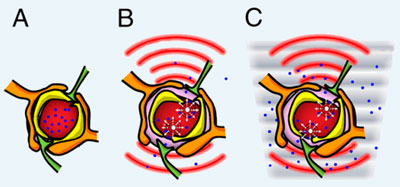
Posted on 08/09/2010 4:02:33 PM PDT by neverdem
A new, non-invasive method to deliver drugs to the brain has been developed by Taiwanese researchers. Using a combination of magnetic nanoparticles and focused ultrasound to pinpoint specific areas, the technique could be very helpful in treating brain tumours.
'The difficulty with treating brain tumours is that the brain is protected by the blood-brain barrier,' explains Pin-Yuan Chen, who led the research at Chang Gung Memorial Hospital in Taiwan. 'This prevents chemotherapy drugs from entering the brain. However, we can open up this barrier in desired locations using focused ultrasound. This allows us to target our treatment effectively and safely.'
Chen's team injected magnetic nanoparticles coated with therapeutic compounds into rats, then applied an external magnetic field to increase the concentration of the nanoparticles in the brain. Next, a low-energy burst of ultrasound was targeted on desired areas, which increased the permeability of the blood-brain barrier and allowed the nanoparticles to diffuse through across. The effect of the ultrasound is temporary, and the barrier returns to normal after a few hours.

|
Ordinarily the blood-brain barrier would prevent nanoparticles crossing to the brain (A), but ultrasound can disrupt the barrier so that the particles can diffuse across (B) and using magnetic targeting helps direct the particles to the desired location (C)
© Proc. Natl. Acad. Scis. USA
|
The advantage of using magnetic nanoparticles is twofold. Firstly, since the nanoparticles can be localised in the brain, far smaller doses are required, which would dramatically reduce any side-effects from the treatment and potentially allow stronger drugs to be used.
Secondly, the magnetic particles show up on magnetic resonance imaging (MRI) scans, so that doctors can follow the progress of the treatment and monitor drug concentrations in the brain. This is important because tumours can have widely differing morphologies and may take up the drug in different amounts.
Chen notes however that further research and development will be needed before the treatment finds its way into hospitals. In particular, the safety of the nanoparticles needs to be assessed as well as determining the best way to apply a magnetic field to localise nanoparticles in the brain.
'This is a fascinating article,' says Jinwoo Cheon, who develops magnetic nanoparticles for cancer treatment at Yonsei University in Seoul, South Korea. 'Many people in nanomedicine have been pursuing so-called "theranostics" - which is therapy plus diagnostics - as a next generation concept that will be essential for personalised medicine with high efficacy. I would say this is one of the most significant successful showcases in this research area.'
Subsequent MRI scans would be contraindicated with any magnetic implant, no? That sounds like a recipe for an instant stroke, IMHO. Methinks I'd prefer a CT scan.
You can link the FReebie pdf article from the abstract. The DOI# is lame.
Two New Paths to the Dream: Regeneration FReebie!
Turning Scar Tissue Into a Beating Heart FReebie!
In breakthrough, nerve connections are regenerated after spinal cord injury FReebie!
FReepmail me if you want on or off my health and science ping list.
Smart. Nice application.
Yeah, but what else gets exchanged during those few hours, and what are the consequences?
Magnetic nanoparticles do show promise, though, for targeting.
I wouldn't think so. The fields for focusing the particles in place and that for MRI are probably completely different. And I would suspect that it would be possible to design the nanoparticles such that they decompose over time, releasing the iron to a soluble form. The technology for "timed release" capability is pretty mature. I think I'd prefer it to the high dose of x-rays in a CT scan.
Disclaimer: Opinions posted on Free Republic are those of the individual posters and do not necessarily represent the opinion of Free Republic or its management. All materials posted herein are protected by copyright law and the exemption for fair use of copyrighted works.